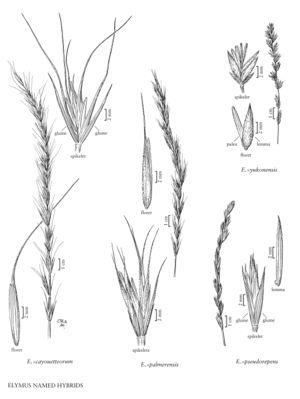Difference between revisions of "Elymus ×yukonensis"
FNA>Volume Importer |
FNA>Volume Importer |
||
| Line 7: | Line 7: | ||
|name=Agropyron yukonense | |name=Agropyron yukonense | ||
|authority=Scribn. & Merr. | |authority=Scribn. & Merr. | ||
| + | |rank=species | ||
}} | }} | ||
|hierarchy=Poaceae;Poaceae subfam. Pooideae;Poaceae tribe Triticeae;Elymus;Elymus ×yukonensis | |hierarchy=Poaceae;Poaceae subfam. Pooideae;Poaceae tribe Triticeae;Elymus;Elymus ×yukonensis | ||
| Line 19: | Line 20: | ||
-->{{Treatment/Body | -->{{Treatment/Body | ||
|distribution=Alaska;B.C. | |distribution=Alaska;B.C. | ||
| − | |discussion=<p>The parents of Elymus ×yukonensis have not been identified. Morphological and geographic considerations suggest that they may be E. lanceolatus subsp. psammophilus (p. 327) and E. alaskanus (p. 326).</p><!-- | + | |discussion=<p>The parents of <i>Elymus ×yukonensis</i> have not been identified. Morphological and geographic considerations suggest that they may be <i>E. lanceolatus </i>subsp.<i> psammophilus</i> (p. 327) and <i>E. alaskanus</i> (p. 326).</p><!-- |
| − | --><p>Elymus ×yukonensis is an Elymus named hybrid</p><!-- | + | --><p><i>Elymus ×yukonensis</i> is an <i>Elymus</i> named hybrid</p><!-- |
| − | --><p>Elymus is notorious for its ability to hybridize. Most of its interspecific hybrids are partially fertile, permitting introgression between the parents. The descriptions provided below are restricted to the named interspecific hybrids. They should be treated with caution and some skepticism; some are based solely on the type specimen, because little other reliably identified material was available. Moreover, as the descriptions of the non-hybrid species indicate, many other interspecific hybrids exist.</p><!-- | + | --><p><i>Elymus</i> is notorious for its ability to hybridize. Most of its interspecific hybrids are partially fertile, permitting introgression between the parents. The descriptions provided below are restricted to the named interspecific hybrids. They should be treated with caution and some skepticism; some are based solely on the type specimen, because little other reliably identified material was available. Moreover, as the descriptions of the non-hybrid species indicate, many other interspecific hybrids exist.</p><!-- |
| − | --><p>The parentage of all hybrids is best determined in the field. Perennial hybrids, such as those in Elymus, can persist in an area after one or both parents have died out, but the simplest assumption is that both are present. Interspecific hybrids of Elymus that have disarticulating rachises presumably have E. elymoides or E. multisetus as one of their parents.</p> | + | --><p>The parentage of all hybrids is best determined in the field. Perennial hybrids, such as those in <i>Elymus</i>, can persist in an area after one or both parents have died out, but the simplest assumption is that both are present. Interspecific hybrids of <i>Elymus</i> that have disarticulating rachises presumably have <i>E. elymoides</i> or <i>E. multisetus</i> as one of their parents.</p> |
|tables= | |tables= | ||
|references= | |references= | ||
| Line 31: | Line 32: | ||
-->{{#Taxon: | -->{{#Taxon: | ||
name=Elymus ×yukonensis | name=Elymus ×yukonensis | ||
| − | |||
|authority=(Scribn. & Merr.) Á. Löve | |authority=(Scribn. & Merr.) Á. Löve | ||
|rank=species | |rank=species | ||
| Line 38: | Line 38: | ||
|basionyms= | |basionyms= | ||
|family=Poaceae | |family=Poaceae | ||
| − | |illustrator=Cindy Roché | + | |illustrator=Cindy Roché;Annaliese Miller |
| + | |illustration copyright=Utah State University | ||
|distribution=Alaska;B.C. | |distribution=Alaska;B.C. | ||
|reference=None | |reference=None | ||
| Line 44: | Line 45: | ||
|publication year= | |publication year= | ||
|special status= | |special status= | ||
| − | |source xml=https:// | + | |source xml=https://jpend@bitbucket.org/aafc-mbb/fna-data-curation.git/src/f50eec43f223ca0e34566be0b046453a0960e173/coarse_grained_fna_xml/V24/V24_483.xml |
|subfamily=Poaceae subfam. Pooideae | |subfamily=Poaceae subfam. Pooideae | ||
|tribe=Poaceae tribe Triticeae | |tribe=Poaceae tribe Triticeae | ||
Revision as of 21:21, 16 December 2019
Plants rhizomatous. Culms about 60 cm, erect. Leaves somewhat basally concentrated; blades 3.5-6 mm wide. Spikes 6-10 cm long, 0.7-1.7 cm wide, with 1 spikelet per node; internodes 6-11 mm. Glumes 4-5.5 mm, about 1/2 the length of the adjacent lemmas, lanceolate, flat, hairy, apices acute or awn-tipped, awns shorter than 1 mm; rachillas densely hairy; lemmas 6-9 mm, densely villous, unawned; anthers 3.3-3.6 mm.
Discussion
The parents of Elymus ×yukonensis have not been identified. Morphological and geographic considerations suggest that they may be E. lanceolatus subsp. psammophilus (p. 327) and E. alaskanus (p. 326).
Elymus ×yukonensis is an Elymus named hybrid
Elymus is notorious for its ability to hybridize. Most of its interspecific hybrids are partially fertile, permitting introgression between the parents. The descriptions provided below are restricted to the named interspecific hybrids. They should be treated with caution and some skepticism; some are based solely on the type specimen, because little other reliably identified material was available. Moreover, as the descriptions of the non-hybrid species indicate, many other interspecific hybrids exist.
The parentage of all hybrids is best determined in the field. Perennial hybrids, such as those in Elymus, can persist in an area after one or both parents have died out, but the simplest assumption is that both are present. Interspecific hybrids of Elymus that have disarticulating rachises presumably have E. elymoides or E. multisetus as one of their parents.
Selected References
None.
